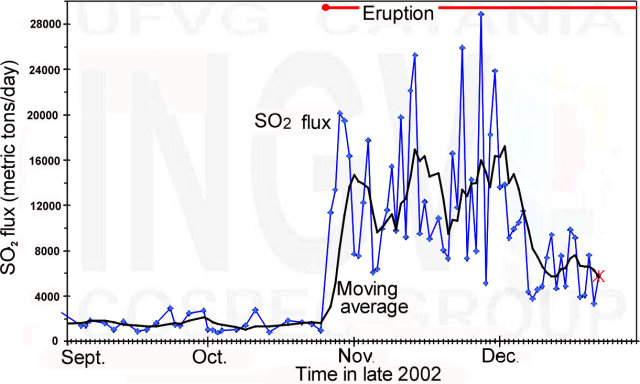Report on Etna (Italy) — December 2002
Bulletin of the Global Volcanism Network, vol. 27, no. 12 (December 2002)
Managing Editor: Richard Wunderman.
Etna (Italy) Late October 2002 earthquake swarm signals start of new flank eruption
Please cite this report as:
Global Volcanism Program, 2002. Report on Etna (Italy) (Wunderman, R., ed.). Bulletin of the Global Volcanism Network, 27:12. Smithsonian Institution. https://doi.org/10.5479/si.GVP.BGVN200212-211060
Etna
Italy
37.748°N, 14.999°E; summit elev. 3357 m
All times are local (unless otherwise noted)
On 26 October 2002 at 2225 a swarm of earthquakes was recorded by the seismic network of the Catania Section of the National Institute of Geophysics and Volcanology (INGV-CT). This signaled the start of a new flank eruption that has formed fissures on the N and S sides of the volcano.
The lava supply from the main vents were cut off by 3 November. At that time both the N and S fissues stopped producing lava flows, although the S fissure continued to discharge fire fountains. After that, 20 m of downslope movement was observed at the most advanced flow front near Piano Provenzana on 5 November. This late movement was caused by channel emptying, and occurred when lava emerging at the main vent, ~5 km upstream, was completely crusted over. No further advancement of the lava flows was observed on the S or N flanks of the volcano after this date. However, while explosive and effusive activity stopped at the N fissure by 5 November, as of 11 November fire fountaining continued at the S vent located at 2,750 m elevation, near Torre del Filosofo. All data (gas emission, volcanic tremor, composition of the ash) suggested a steady state at this vent. Ash fallout caused intermittent disruption at the Catania airport and damage to buildings.
The eruption continued into December 2002. Lava flows and Strombolian activity continued on the S flank from vents at 2,750 m elevation. Ash emission from the 2,750 m cinder cone significantly declined on 17 December, allowing the local airport of Catania to reopen.
The two vents, which opened at the SE base of the 2,750 m cinder cone on 9-10 December, fed four major lava flows spreading S and SW. A lava flow spreading S on 13 December approached the Rifugio Sapienza and eventually crossed a road on 17 December. An overflow from the main lava channel covered a building and caused a strong explosion in the Rifugio Sapienza area during the night of 17 December, injuring 32 people. The explosion was not directly caused by the eruption, but by vaporization of oil or water inside the building while it was covered by the expanding lava flow. The effusion rate from the two vents gradually decreased, eventually causing the closure of the western vent and then the lack of supply to the lava flows spreading SW towards Monte Nero.
A new vent opened on 17 December at the S base of the 2,750 m cinder cone, a few meters W of the previous vents. A lava flow soon started from this vent, spreading SW towards Monte Nero. The new vent cut supply to the flows expanding S towards Rifugio Sapienza and formed a fan of thin lava flows spreading S, SSW and SW. The lower lava output produced shorter flows, which spread up to 2.5 km from the vent, without threatening the tourist facilities at Rifugio Sapienza. Lava flows spreading from the 17 December vent slowed down and crusted over on 22 December, when a new vent opened at the SW base of the 2,750 m cinder cone. A flow, again directed SW towards Monte Nero, originated from this vent and was expanding in this direction on 23 December.
SO2 emission measured daily during the eruption had significantly decreased as of 1 December, when the previous values of about 20,000 tons per day decreased to about 7,000 tons per day (figure 101). The lower gas output, the decrease in effusion rate, and the lower emission of ash from the summit, suggested a declining stage of the eruption.
Updated maps of the lava flows, and reports of the eruptive activity, gas emission and ash composition (in Italian), can be found on the INGV-CT website.
Geological Summary. Mount Etna, towering above Catania on the island of Sicily, has one of the world's longest documented records of volcanism, dating back to 1500 BCE. Historical lava flows of basaltic composition cover much of the surface of this massive volcano, whose edifice is the highest and most voluminous in Italy. The Mongibello stratovolcano, truncated by several small calderas, was constructed during the late Pleistocene and Holocene over an older shield volcano. The most prominent morphological feature of Etna is the Valle del Bove, a 5 x 10 km caldera open to the east. Two styles of eruptive activity typically occur, sometimes simultaneously. Persistent explosive eruptions, sometimes with minor lava emissions, take place from one or more summit craters. Flank vents, typically with higher effusion rates, are less frequently active and originate from fissures that open progressively downward from near the summit (usually accompanied by Strombolian eruptions at the upper end). Cinder cones are commonly constructed over the vents of lower-flank lava flows. Lava flows extend to the foot of the volcano on all sides and have reached the sea over a broad area on the SE flank.
Information Contacts: Sonia Calvari, Istituto Nazionale di Geofisica e Vulcanologia (INGV), Sezione di Catania, Piazza Roma 2, 95123 Catania (URL: http://www.ct.ingv.it/).


